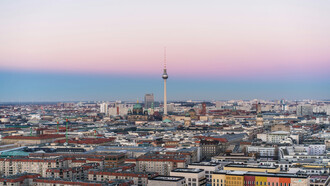When Stalin was just a revolutionary agitator, he published an article on Marxism and national questions. After having taken the power, he applied the program defined in this text, masking his tyranny under various pretexts, claiming for instance that the USSR would protect the rights of peoples and awaken their cultures…
So, in 1934 he founded the Institute of Ethnography in order to study traditions and lifestyles of the many peoples gathered under the Soviet banner. Ethnographers also had a more direct political role, finalizing the borders of the Soviet republics of Central Asia, such as Tajikistan and Uzbekistan. Then, the architects, who were active in the capitals of these countries, were encouraged to construct buildings using some elements of the local cultures to show that the USSR had carefully equipped these territories. The goal was clearly ideological: to convince these peoples that the administration in Moscow respects their identity.
For example, in Tajikistan – a country largely mountainous, with a poor agriculture – the capital, Dushanbe, had benefited from fairly substantial budgets during the decades 1930-1950, which made it possible to build a city worthy of the name. Though the architecture of housing and schools was very simple, several essential facilities for social life were designed by synthesizing classic compositions with some details from traditional Tajik culture.
Started in 1939 and completed during the Second World War, the Dushanbe Opera House is a typical example of this singular creative assembly. Designed by Dmitri Bilibin, V.D. Golli, A.A. Longer – Russian architects – this monument eloquently speaks to us of the Stalinist policy of developing musical culture. Curiously, Stalin neglected the fact that opera had been a very bourgeois musical genre, considering that the time had come for the proletariat to appreciate Verdi’s great arias and Tchaikovsky’s ballets… And of course, the operas of Soviet composers, glorifying the Revolution!
While the architectural treatises of antiquity and the Renaissance considered the Ionic order as "Asian", remembering this curious ethno-architectural definition, the Stalinist architects had drawn columns with Ionic capitals exacerbating their supposedly Asian character. More than an aesthetic concession to the local elites, it was a formal principle that guided the design of the whole building. So, the large plaster panels decorating the great staircase were inspired by the Samanid monuments of Bukhara. In the same way, all the painted ceilings of the Opera remind of the oriental carpets… The result skillfully combines classic splendor and Tajik delicacy. Despite the charm of the building, the small museum presenting a choice of archives reveals much less pleasant realities behind the scenes. On the photo albums, the faces of the dancers or musicians condemned by the repressive bodies of the Soviet Union have been erased...
Built in the 1950s, the Rohat Tea House is the work of two Russian architects, Konstantin Terletski and Danil Guendlin, who cooperated with their Tajik colleague Mirzorahmat Alimov. So this trio looked for greater loyalty to local customs. With an open colonnade, its gallery allows natural ventilation to cool customers. While the walls are decorated with plaster panels with abstract patterns in the Islamic tradition, the graceful columns are carrying a charming ceiling painted in bright colors, continuing the old Tajik style. With its open space and its abstract decor, this tea house delicately updates the oriental practice of tasting this hot drink.
Even more imaginative, the entrance Pavilion of the Botanical Garden brings together memories of Persian architecture from the Achaemenid Empire with Egyptian details, as well as Samanid-style mosaics, as in Bukhara… Surprising cultural collage, perhaps a slightly inconsistent, but visually delicious! For the moment, I have not yet identified the authors of this building. I hope that Tajik colleagues can help me find their names, to finally celebrate the memory of those who created this artistic gem.
However, we shouldn’t be taken in: the pleasant facades of these bindings hide behind their elegance the faults of a totalitarian regime. Although based on a humanist ideal, the USSR degenerated into a criminal monstrosity. So the contemplation of these monuments remains ambiguous.
On the one hand, by his chilling cynicism, Stalin has caused countless deaths. But these monuments also testify to the complex cultural creativity of his regime, so much wishing to create a powerful global culture. Behind its cruel appetite for power, this claimed universalism has nevertheless led sometimes to surprising particularisms.















